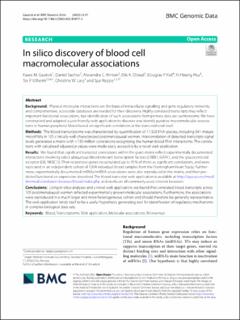| dc.contributor.author | Gautvik, Kaare M | |
| dc.contributor.author | Sachse, Daniel | |
| dc.contributor.author | Hinton, Alexandra C. | |
| dc.contributor.author | Olstad, Ole Kristoffer | |
| dc.contributor.author | Kiel, Douglas P. | |
| dc.contributor.author | Hsu, Yi-Hsiang | |
| dc.contributor.author | Utheim, Tor Paaske | |
| dc.contributor.author | Lary, Christine W. | |
| dc.contributor.author | Reppe, Sjur | |
| dc.date.accessioned | 2023-03-30T14:16:50Z | |
| dc.date.available | 2023-03-30T14:16:50Z | |
| dc.date.created | 2022-08-22T15:41:55Z | |
| dc.date.issued | 2022 | |
| dc.identifier.citation | Gautvik, K. M., Sachse, D., Hinton, A. C., Olstad, O. K., Kiel, D. P., Hsu, Y. H., ... & Reppe, S. (2022). In silico discovery of blood cell macromolecular associations. BMC genomic data, 23(1), 57. | en_US |
| dc.identifier.issn | 2730-6844 | |
| dc.identifier.uri | https://hdl.handle.net/11250/3061238 | |
| dc.description.abstract | Background
Physical molecular interactions are the basis of intracellular signalling and gene regulatory networks, and comprehensive, accessible databases are needed for their discovery. Highly correlated transcripts may reflect important functional associations, but identification of such associations from primary data are cumbersome. We have constructed and adapted a user-friendly web application to discover and identify putative macromolecular associations in human peripheral blood based on significant correlations at the transcriptional level.
Methods
The blood transcriptome was characterized by quantification of 17,328 RNA species, including 341 mature microRNAs in 105 clinically well-characterized postmenopausal women. Intercorrelation of detected transcripts signal levels generated a matrix with > 150 million correlations recognizing the human blood RNA interactome. The correlations with calculated adjusted p-values were made easily accessible by a novel web application.
Results
We found that significant transcript correlations within the giant matrix reflect experimentally documented interactions involving select ubiquitous blood relevant transcription factors (CREB1, GATA1, and the glucocorticoid receptor (GR, NR3C1)). Their responsive genes recapitulated up to 91% of these as significant correlations, and were replicated in an independent cohort of 1204 individual blood samples from the Framingham Heart Study. Furthermore, experimentally documented mRNAs/miRNA associations were also reproduced in the matrix, and their predicted functional co-expression described. The blood transcript web application is available at http://app.uio.no/med/klinmed/correlation-browser/blood/index.php and works on all commonly used internet browsers.
Conclusions
Using in silico analyses and a novel web application, we found that correlated blood transcripts across 105 postmenopausal women reflected experimentally proven molecular associations. Furthermore, the associations were reproduced in a much larger and more heterogeneous cohort and should therefore be generally representative. The web application lends itself to be a useful hypothesis generating tool for identification of regulatory mechanisms in complex biological data sets. | en_US |
| dc.language.iso | eng | en_US |
| dc.publisher | BMC | en_US |
| dc.rights | Navngivelse 4.0 Internasjonal | * |
| dc.rights.uri | http://creativecommons.org/licenses/by/4.0/deed.no | * |
| dc.title | In silico discovery of blood cell macromolecular associations | en_US |
| dc.type | Journal article | en_US |
| dc.description.version | publishedVersion | en_US |
| dc.rights.holder | The authors | en_US |
| dc.subject.nsi | VDP::Medisinske Fag: 700 | en_US |
| dc.source.volume | 23 | en_US |
| dc.source.journal | BMC Genomic Data | en_US |
| dc.identifier.doi | 10.1186/s12863-022-01077-3 | |
| dc.identifier.cristin | 2045061 | |
| cristin.ispublished | true | |
| cristin.fulltext | original | |

